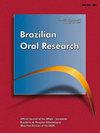Sense of coherence and oral health-related quality of life among southern Brazilian male adolescents
IF 2.5
4区 医学
Q2 Dentistry
引用次数: 0
Abstract
This study evaluated the association between sense of coherence (SoC) and oral health-related quality of life (OHRQoL) among conscripts of the Brazilian Army, in two cities of southern Brazil. A cross-sectional study included all 18-19-year-old adolescents who joined the Brazilian Army as draftees for mandatory military service in the cities of Itaqui, RS, and Santiago, RS (n = 505). Data collection was conducted from 2019 to 2021, and included the application of questionnaires and a clinical oral examination to record gingivitis, malocclusion, and dental caries. OHRQoL was collected through the Brazilian short version of the Oral Health Impact Profile (OHIP), composed of 14 questions. The adolescents’ SoC was assessed using the validated Brazilian version of the SOC-13 scale. The primary outcome of this study was OHRQoL, modeled as a discrete variable (OHIP-14 scores). The main predictor variable was SoC, categorized as low, moderate, or high. The association between predictor variables and OHRQoL was assessed by Poisson regression models using a hierarchical approach. Unadjusted and adjusted rate ratios (RR), and 95% confidence intervals (CI) were estimated. All the analyses were performed using STATA software version 14.2. Adolescents with a moderate and high SoC had 27% (RR = 0.73, 95%CI = 0.64–0.84) and 51% (RR = 0.49, 95%CI = 0.41–0.58) lower mean OHIP-14 scores, respectively, than those with a low SoC score, after the inclusion of behavioral and clinical variables. This study showed a significant association between SoC and OHRQoL among 18–19-year-old southern Brazilian adolescents. Strengthening the SoC as a psychosocial resource may improve the well-being and OHRQoL of adolescents.巴西南部男性青少年的连贯感和口腔健康相关生活质量
本研究评估了巴西南部两个城市巴西军队应征入伍者的连贯感(SoC)与口腔健康相关生活质量(OHRQoL)之间的关系。横断面研究纳入了巴西伊塔基市和圣地亚哥市所有18-19岁的青少年,这些青少年作为义务兵役的应征入伍者加入了巴西军队(n = 505)。数据收集于2019年至2021年进行,包括使用问卷调查和临床口腔检查,记录牙龈炎、错颌合和龋齿。OHRQoL是通过巴西口腔健康影响概况(OHIP)的简短版本收集的,由14个问题组成。使用经过验证的巴西版SoC -13量表对青少年的SoC进行评估。本研究的主要结局是OHRQoL,建模为离散变量(OHIP-14评分)。主要预测变量是SoC,分为低、中、高三个等级。预测变量与OHRQoL之间的关系通过泊松回归模型采用分层方法进行评估。估计未调整和调整的率比(RR)和95%置信区间(CI)。所有分析均使用STATA软件14.2版进行。在纳入行为和临床变量后,中度和高SoC青少年的平均OHIP-14得分分别比低SoC青少年低27% (RR = 0.73, 95%CI = 0.64-0.84)和51% (RR = 0.49, 95%CI = 0.41-0.58)。本研究显示18 - 19岁巴西南部青少年SoC与OHRQoL之间存在显著相关性。加强社会归属感作为一种社会心理资源可以改善青少年的幸福感和OHRQoL。
本文章由计算机程序翻译,如有差异,请以英文原文为准。
求助全文
约1分钟内获得全文
求助全文
来源期刊

Brazilian Oral Research
DENTISTRY, ORAL SURGERY & MEDICINE-
CiteScore
3.70
自引率
4.00%
发文量
107
审稿时长
12 weeks
 求助内容:
求助内容: 应助结果提醒方式:
应助结果提醒方式:


